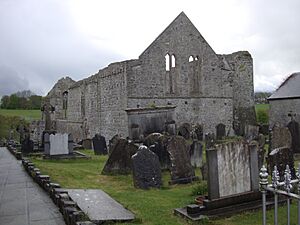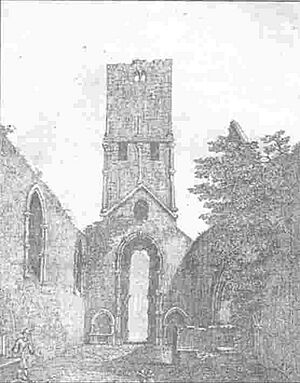Buttevant Franciscan Friary facts for kids
The Buttevant Franciscan Friary is an old religious building from the 1200s. It's located right in the middle of Buttevant, a town in County Cork, Ireland. It was home to a group of Franciscans, who are a type of Catholic friar. Friaries are places where friars live, pray, and work.
Contents
The Friary's Beginnings
The Franciscan Order first came to Ireland in 1224. One of their first homes was in Youghal. From there, an important new friary was started in Buttevant. This friary was dedicated to Saint Thomas Becket. It was the only Franciscan house in North Cork.
Records show that the Buttevant Friary was founded in 1251 by a man named David Óg de Barry. He also provided land for the friars to use.
Early Life at the Friary
By 1324, the Buttevant Friary had friars from both Irish and Anglo-Norman backgrounds. It was important enough to have its own studium, which was a special school for friars to study.
However, there were some disagreements among the friars because of their different backgrounds. In 1327, a church group decided to move a Gaelic-speaking teacher from Buttevant to another friary. Also, in 1325, the friary's control was moved to Cork. This meant it was no longer controlled by Irish leaders but by Anglo-Norman ones.
The Friary and the Law
In the Middle Ages, friaries were often important places in towns. The front door or "vestibule" of the Buttevant Friary was sometimes used for important legal meetings. For example, in 1402, a knight named Sir John de Barry made an agreement with the Bishop of Cloyne right at the friary's entrance. This shows how central the friary was to daily life and law in the town.
Changes and Challenges
Around 1540, the friary faced a big change. The government decided to close down many religious houses, including Buttevant Friary. This was part of a wider movement called the Dissolution of the Monasteries.
When the friary was examined, it was found to have the church, living quarters, a garden, a cemetery, and a watermill. All its property was valued at a certain amount.
New Owners and Rebellions
In 1570, Lord James de Barry, who was the Viscount Buttevant, was given a lease to use the friary's land. However, when the Desmond Rebellions broke out, Lord Buttevant joined the rebels. Because of this, his lands, including the friary, were taken away. The friary then went to Edmund Spenser, a famous writer, as part of the Plantations of Ireland, which were efforts to settle English people in Ireland.
Even though the friary was officially closed, some friars tried to live there again. By 1615, the friary was back in the hands of Lord Barry's family. But they had rules that the friars couldn't live in the main buildings. Still, two friars lived in the town and helped with burials.
In 1615, the large church of the friary was still standing and had a wooden roof. Many important families had their tombs inside. The other friary buildings were not as grand, but they were large.
Complaints and Continued Presence
In 1607, the Protestant bishop of Cork, William Lyon, complained that friars were still active in Buttevant. He mentioned that they held "continual and daily masses" and meetings that he felt were not good for the King. He even named some of the friars, like Conor M'Morice.
A report from 1626-1629 also mentioned the Buttevant Friary. It said that during the time of Queen Elizabeth I, friars were sometimes forced out, and some were even put in prison. The statues in the church were broken, but the church building itself was left standing because of the important tombs inside. However, the other friary buildings were destroyed. Despite this, some friars continued to live in or near the friary even in 1629. The report also noted that the Barry family and other noble families had their tombs there.
The Friary in War
During the Irish Rebellion of 1641, the friars in Buttevant welcomed the Confederate Catholic army. The leader of the friars, Father Boetius Egan, even joined the Confederate Parliament in Kilkenny.
However, during the Irish Confederate Wars, a Protestant commander named Murrough O'Brien gathered his army in Buttevant. He then burned the friary church. Inchiquin was known for burning things, earning him the nickname "Murrough of the Burnings." It's said that many bones from the nearby Battle of Knocknanuss (1647) were placed in the crypt under the church.
The Final Years
By the 1700s, the Franciscan presence in Buttevant was very small. In 1731, a report noted there was only "one old Mass House" and "one or two old fryers" living in a thatched house within the old abbey's area.
An old list from around 1820, made by Bishop William Coppinger, names what might have been the last Franciscan friars of Buttevant. These included Pat Daly, Pat O'Neill, David Roche, and Daniel McAuliffe. By 1820, after nearly 600 years, the Franciscans were no longer present in Buttevant.
What Remains Today
Samuel Lewis's Topographical Dictionary of Ireland from 1837 describes the ruins of the friary. He noted that they are beautifully located on the steep bank of the Awbeg river. The ruins mostly consist of the walls of the main church areas. The upper part of the central tower, which was supported by graceful arches, fell down in 1814.
The tomb of the founder, David de Barry, is thought to be in the center of the church, marked by some broken stones. On the south side of the church, there are remains of a well-proportioned chapel. Both in the chapel and the main church, there are many tombs and inscriptions for important families like the Barrys, Fitzgeralds, and Lombards.
Images for kids







